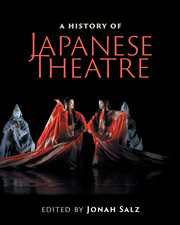Book contents
- Frontmatter
- Contents
- List of figures
- List of tables
- Contributors
- Contributors’ biographies
- Foreword
- Acknowledgments
- Note on Japanese terms
- List of abbreviations
- Timeline
- Editor's introduction
- I Traditional theatres
- Preface to Part I Japanese civilization arises
- II Modern theatres
- Preface to Part II
- 6 Birth of modern theatre: shimpa and shingeki
- Interlude Modern comedies and early musicals
- Interlude Takarazuka: all-girls’ revue and musicals
- 7 Rise of shingeki: Western-style theatre
- Interlude Manzai and Yoshimoto vaudeville comedy
- 8 Wartime colonial and traditional theatre
- Interlude Kami-shibai: picture-card storytelling
- 9 Maturing shingeki theatre
- Interlude Postwar musicals and commercial theatre
- 10 Sixties Theatre
- Interlude Butoh: dance of darkness and light
- 11 Contemporary theatre
- Interlude Tokyo: world theatre capital
- Interlude Charting Tokyo theatre today: 24 November 2012
- Interlude Modern theatre tomorrow: interview with Oriza Hirata
- III Arcs and patterns
- IV Theatre architecture
- Preface to Part IV Evolution of Japanese theatre architecture
- V Theatre criticism
- VI Intercultural influences
- Epilogue: Frozen words and mythology
- Further reading
- Index
- References
Interlude Modern comedies and early musicals
from Preface to Part II
Published online by Cambridge University Press: 05 July 2016
- Frontmatter
- Contents
- List of figures
- List of tables
- Contributors
- Contributors’ biographies
- Foreword
- Acknowledgments
- Note on Japanese terms
- List of abbreviations
- Timeline
- Editor's introduction
- I Traditional theatres
- Preface to Part I Japanese civilization arises
- II Modern theatres
- Preface to Part II
- 6 Birth of modern theatre: shimpa and shingeki
- Interlude Modern comedies and early musicals
- Interlude Takarazuka: all-girls’ revue and musicals
- 7 Rise of shingeki: Western-style theatre
- Interlude Manzai and Yoshimoto vaudeville comedy
- 8 Wartime colonial and traditional theatre
- Interlude Kami-shibai: picture-card storytelling
- 9 Maturing shingeki theatre
- Interlude Postwar musicals and commercial theatre
- 10 Sixties Theatre
- Interlude Butoh: dance of darkness and light
- 11 Contemporary theatre
- Interlude Tokyo: world theatre capital
- Interlude Charting Tokyo theatre today: 24 November 2012
- Interlude Modern theatre tomorrow: interview with Oriza Hirata
- III Arcs and patterns
- IV Theatre architecture
- Preface to Part IV Evolution of Japanese theatre architecture
- V Theatre criticism
- VI Intercultural influences
- Epilogue: Frozen words and mythology
- Further reading
- Index
- References
Summary
One Western custom that quickly took hold in Tokyo and other urban centers among working- and middle-class audiences early in the twentieth century was a night out for vaudeville-style light comedy or musical entertainments.
Light comedy in major Osaka kabuki productions
Soganoya Gorō (1877–1948) and Soganoya Jūrō (1869–1925) were originally actors of minor roles in major Osaka kabuki productions. In 1904 they founded the first Japanese troupe specializing in “comedies” (kigeki, 喜劇), which came to enjoy nationwide fame as Soganoya Comedy. Their early performances were updated versions of traditional niwaka shibai, impromptu farce performed mainly by non-professionals at parties and in the street.
Soganoya Comedy employed stage properties, sound effects, music, and costumes, but its contents reflected the spirit of the new age, as in their masterpiece, Muhitsu no gōgai (Newspaper extra for the illiterates, 1904). Premiering three days after the Russo-Japanese War began, it was a farce about illiterate people who mistake the advertising bills of a Western-style restaurant for a newspaper extra reporting on the declaration of war. Soganoya Comedy established the basis for Japanese modern comedy, incorporating the customs and spirit of the new era. Both Gorō and Jūrō wrote and directed the scripts, and performed the principal roles. Their work, especially Gorō's, was popular for its sentimental human touches, mingling common people's delights and sorrows with laughter.
In 1911, the Teikoku Gekijō (Imperial Theatre) opened in Tokyo as Japan's first full-scale Western-style theatre: it had a steel-framed, reinforced concrete structure, chair seating, and European-style facilities such as restaurants, smoking rooms, and cloakrooms. European-educated industrialist Masuda Tarō (1875–1953), one of its executive directors, also wrote light, sophisticated comedies and musicals. While Soganoya Comedy's audiences were mostly working-class townspeople, those attending Masuda's works were middle class. Masuda's comedies were far more modern, played and sung by actresses educated at the Imperial Theatre Academy, modeled on European operettas and music hall repertoire.
Musicals for the masses: Asakusa Opera
Regular commercial performances of Japanese operas, the archetypal synthesis of European arts, were intended as a sure means to make the Western world recognize the extent of Japanese modernization. The training program for opera and ballet performers at the Imperial's Music and Drama Department, however, had to be canceled after five years through a failure to attract audiences.
- Type
- Chapter
- Information
- A History of Japanese Theatre , pp. 226 - 229Publisher: Cambridge University PressPrint publication year: 2016



